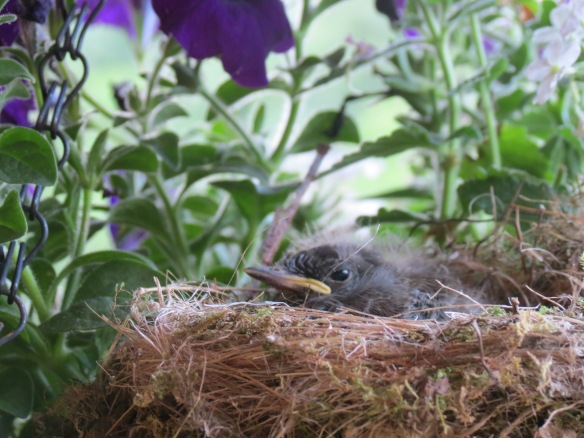Well, it happened. I was watering the flowers on the front porch when a bird zoomed out of the phoebe nest and flew into a nearby tree. At first I thought it was the mother phoebe, but when I checked the nest, it was empty! The young phoebe had fledged! I watched him fly from one branch to another, which told me he had no injuries. Mama phoebe was close by, so she will show him the ropes. I didn’t expect it to happen so soon, but I’m happy that the little guy was able to leave the nest and start life on his own.
Monthly Archives: July 2013
Can You ID These Two Birds?
Sometimes, particularly in late spring and early summer, when juvenile birds haven’t yet grown in their adult plumage, it’s tough to identify them. Other times, a new bird shows up that you haven’t seen before and it doesn’t look like anything in the bird field guides. Don’t you just hate it when that happens?
I came across this bird on the side of the gravel road we live on. It’s not a great picture and he’s well camouflaged, so you have to look closely. I thought it might be an Ovenbird, but no. The bird that I think it is is sparrow-sized and likes areas with rushing streams and clear brooks, while its northern counterpart prefers swamps and bogs.
This one really threw me. I became very excited when I first saw it – a new bird to add to my list of birds seen on our farm (65 and counting). I felt sure that the reddish-brown on the bird’s breast would give it away, but no such luck. I was beginning to get frustrated when I figured it out. We have a lot of them on our farm; this one is a juvenile.
Can you identify one or both of these birds?
Update: A Lucky Survivor!
This morning I thought both baby birds had succumbed to the attack of the black snake last night. The smaller of the two was cold to the touch and obviously dead; the larger one, though still warm to the touch, was unresponsive and I presumed, dying.
You can imagine my surprise when a couple hours later I heard a little chirp. At first I thought I was hearing the birds outside, but when I checked, one of the babies was moving. I could see his eyes were open and as I approached, his beak opened wide – he was hungry!
I couldn’t put the nest back on the ledge for fear the baby would fall out, so I placed it and the little bird in a hanging pot of petunias close to the site of the original nest and waited to see what happened. The distraught parents had been hanging around all morning, not knowing what to do. When the baby heard them calling, he began cheeping and no sooner had I walked away than they flew over. They were both very animated, obviously glad to see that one of their chicks had survived.
Here’s a picture of the little guy in the nest this evening. He’s alert and eating.
I hope he makes it. Only time will tell if he suffered any internal injuries.
The Birds Outside My Window
During the bird nesting season, our porch rafters are quite a popular place. Last spring, I wrote about the Eastern Phoebes that raised five offspring on our front porch (https://woodandfield.wordpress.com/2012/05/23/safe-haven/).
This spring, the pair returned to build their nest of mud, lichens, and moss on the same ledge where they successfully raised their offspring last year. Likewise, a pair of Eastern Bluebirds returned to raise another generation in a birdhouse on the front porch. Adding to the menagerie, House Wrens are nesting on the back porch. I find it amazing that some birds choose to raise their young so close to all our comings and goings, not to mention the noise from the lawn mower and weed whacker, and dogs racing around barking at the deer, fox, and other critters that occasionally wander through.
The list of nest predators is a long one: hawks, owls, crows, blue jays, weasels, fox, squirrels, snakes, and cats. In the wild, the odds are stacked against the young nestlings. So, weighing the scales, it would seem the lesser of the two evils to endure the closeness of humans. In any event, it ended well for all the little ones last year. All of the offspring survived to leave the nest and start out life on their own.
But, alas, the nestlings can’t be protected from every predator. Last night while we were watching TV, we heard a loud “thump” out on the porch. When we investigated, we saw that a black snake had knocked down the phoebe nest and was in the process of eating one of the babies(!) My husband relocated the snake to the woods while I inspected the nest, which was, amazingly, still largely in tact. Two babies were under the nest and were still alive, so I scooped up the nest and babies and took them into the house for the night.
By this morning, the babies had died, probably from internal injuries suffered from the fall. I know it’s a part of Nature, but loss of any life makes me sad. I take hope in knowing that in this season of renewal, perhaps the phoebes will try again. I miss the pair’s constant “phoebe, phoebe” back-and-forth calling as they busily went about their parenting responsibilities.
When I bought my farm, I did not know what a bargain I had in the bluebirds, daffodils and thrushes; as little did I know what sublime mornings and sunsets I was buying. Ralph Waldo Emerson





